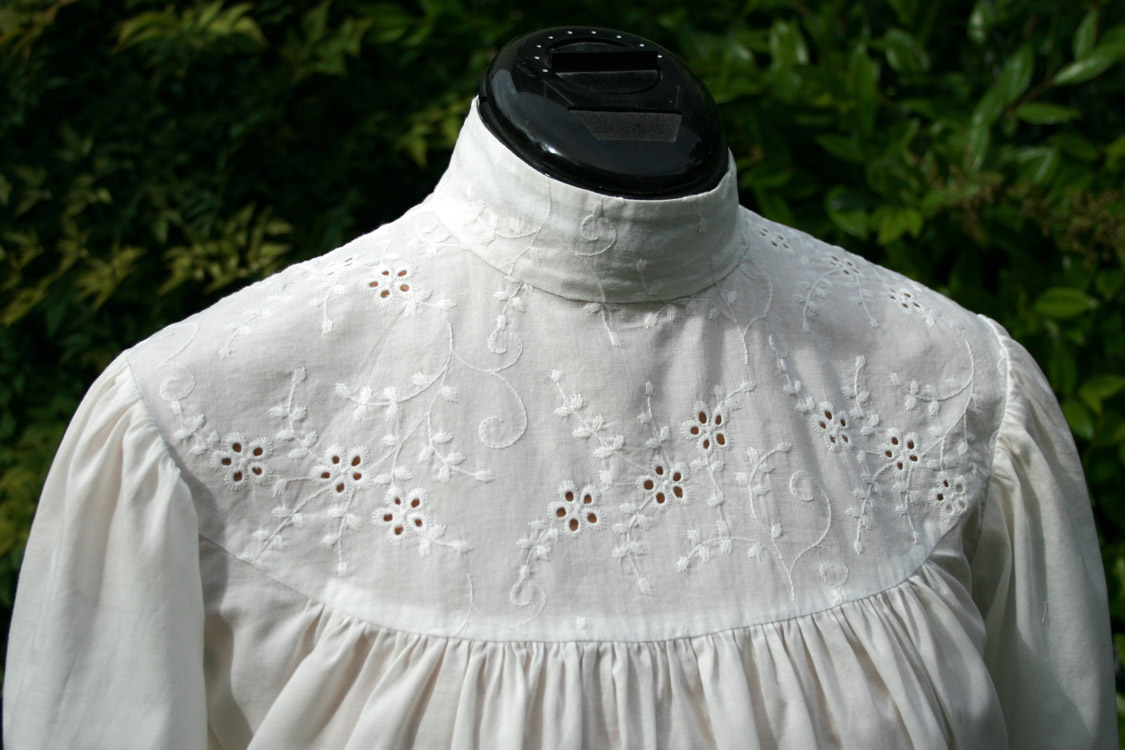
July 2011 – April 2013
A 1905 – 1909 everyday Edwardian ensemble for picnics and outdoor costume gatherings. The skirt and blouse, described below, are accessorized with my dip-waist belt and hat. The foundation layers, described on various underthings pages, consist of an Edwardian corset girdle and yoke petticoats, a modern bra, and my Victorian bum pad. It’s very comfortable for an all-day event. An S-bend corset would also be appropriate with this outfit. But I suspect there would be little point in building one. For better or for worse, I think my silhouette looks about as authentic as the clothing and hair. Everything is relative. I have justifications!
Blouse (July – August 2011)
A blouse from Folkwear’s #205 Gibson Girl. The yoke is 100% cotton embroidered lawn, purchased a few years ago with this pattern in mind. The body is in a plain matching cotton lawn with shell buttons for the back closure. The blouse is finished with 3/16″ french seams, while the yoke and armscye have 1/4″ bindings. I left off the sleeve cuffs and used narrow bindings instead.



The pattern has a very wide shoulder line. After the first mockup a few years ago, it seemed to need adjusting. But now I see it looks appropriate for the 1900s.
I wanted my embroidery to look as though it were intentionally designed for the blouse. But my eyelet fabric has an asymmetrical pattern. I recut it twice before settling on a version I liked: lining up the clusters of flowers so they followed the curve of the yoke. It also took two tries to cut the collar. When I included eyelets, it was a mess. Now the collar has embroidered stems only and no eyelet holes.
Images such as these three Edwardian ladies inspired me to make a few alterations to the pattern. These included a taller collar – and I used my trusty Laughing Moon guimpe pattern for a closer fit. The sleeves were cut fuller and shorter so they poof out around elbow level. The hem was lengthened. The gathers at the back waist were too high for me, so I decided to skip them. But I did end up adding a waist tape to control the fullness.

1905 – 1909 Hat with roses (June – July 2014)
This nicely woven vintage straw hat was blocked over a kitchen bowl to give it a slightly wider crown. Inside the crown, I added a lining with an adjustable drawstring. This allows the hat to sit high on the head (and it’s a common feature in Edwardian originals). The “silk” flowers from Michaels were made softer by removing the plastic spacers, then basting the petals back together by hand.
Skirt (March – April 2013)
Folkwear’s #209, “Walking Skirt” pattern in a black sheer wool. It’s the fourth time I’ve used the pattern.



